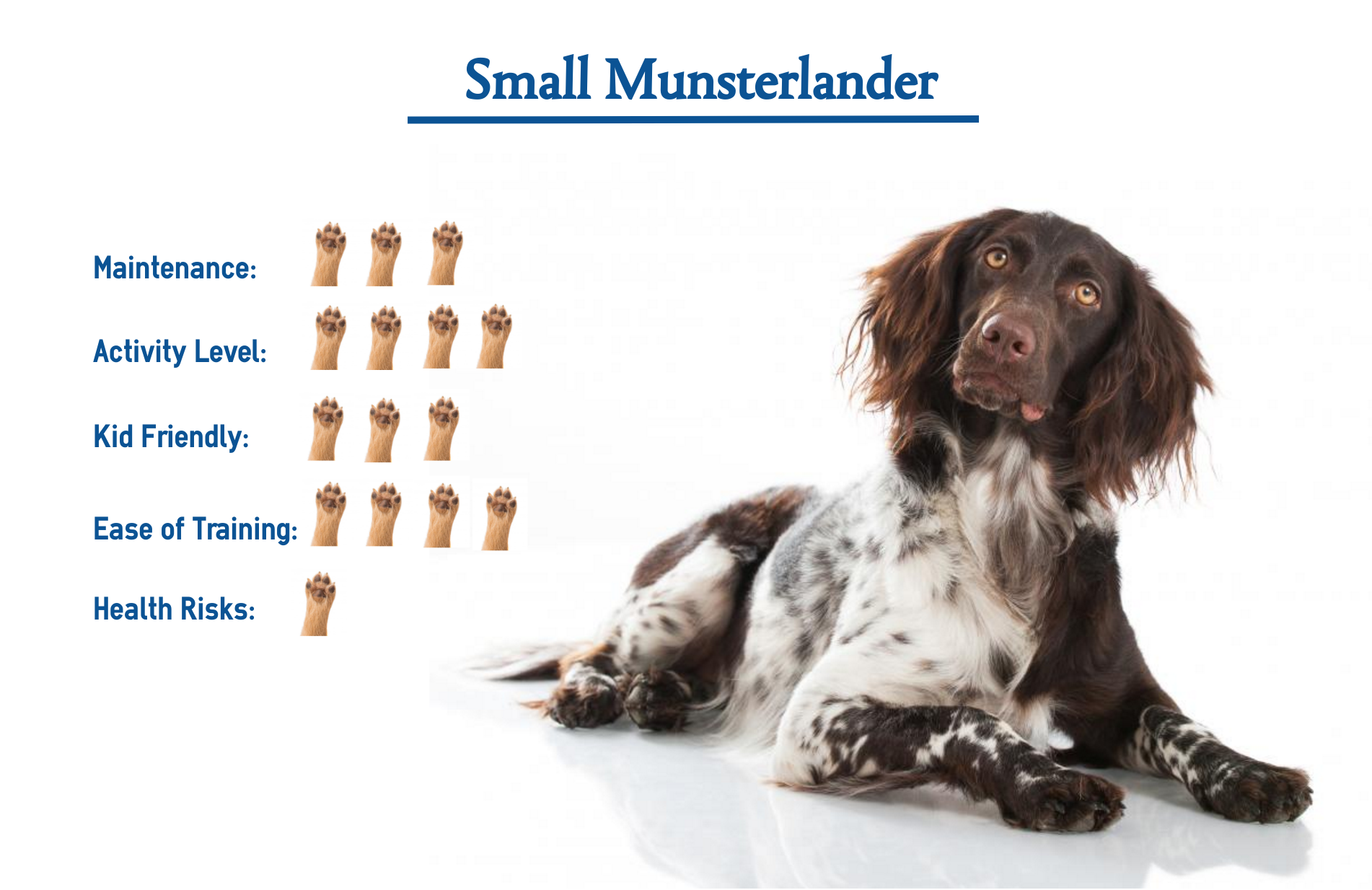There are many things to love about a Small Munsterlander, but for us here at IndulgeYourPet, his affection and friendliness top the charts. But, like any dog, this one’s not perfect for everyone. And while it’s difficult for us to think of a reason not to adopt one of these incredible dogs, the last thing we want is a Small Munsterlander to end up in the “wrong” home. And by “wrong,” we mean one that isn’t ideally suited for one of these loving yet very active dogs.
Which is why…
We wanted to take a moment and discuss exactly what it might be like to own one of these guys. This way, if you’re ever allowed to make one of them your own, you’ll know immediately if that’s going to be a good idea!
So, without further ado, let’s dive right in.
Fast Facts about Small Munsterlander Pointers
Country of Origin: Germany
Original Purpose: Help Falconers and hunters to make the catch!
Height: 18 to 23 inches at the shoulder
Weight: 30 to 60 pounds
Dog Breed Classification: Not “officially” recognized by the American Kennel Club yet.
Lifespan: 11-15 years
Origin of Small Munsterlanders
As we’ve already stated, the Small Munsterlander is a dog breed initially created in Germany sometime during the early to mid-19th century. In Germany, however, the species may not be called a “Small Munsterlander.” Instead, it may go by the name of Kleiner Munsterlander. This is because “Kleiner” means minor in German.
Its primary purpose…
Back then, to perform as a versatile hunting dog, capable of locating and flushing out birds and retrieving them on dry land or water. Unfortunately, like many dog breeds in Europe during World War I and II, these dogs faced difficulty, but they managed to persevere rather than face extinction. The Small Munsterlander Club of North America was created in the United States. The United Kennel Club also recognizes the dog.
Physical Characteristics
Though they are called “small,” they aren’t tiny like little lap dogs. They are more rightly considered mid-sized dogs. The name “small” is just in comparison to Large Munsterlanders, which are more extensive (though only by 15-20 pounds on average). Their coats are a combination of brown and white. Some appear spotted in some sections, while others are more solid colors in some areas. They have long, floppy ears and a slightly bushy tail. The small and Large Munsterlander look pretty much the same aside from weight and height.
Grooming
These dog dogs have a fur coat that can shed. To keep the knots out, and to avoid excess hair fall, give your dog a good brushing every 4-8 days, depending on his activity level. If it’s the summer, you’ll probably want to do it more since he’ll likely work up a bit of a sweat, thus producing more oils. If your dog is hunting, you must do it more often. And just like many other “types” of dogs, you’ll probably want to take them to a professional groomer once in six months.
Personality and Temperament
These are amiable and primarily easy-going dogs. However, they are slightly less pleasant when it comes to strangers. They may be a bit standoffish compared to the lovey, kissy pup you’re used to. But remember, a Small Munsterlander puppy needs to be trained early on so that you can make sure they don’t turn into a stubborn adult dog. You can put them in puppy obedience school as early as 2 ½ months. Your class may want puppies vaccinated before joining, though. So check on that.
One great thing…
About the Munsterlander, they do wind up adapting well. Even though this dog is one of the hunting breeds, he will still be OK to be your companion chilling in front of the TV. That’s not to say you shouldn’t let him run around but to say he won’t go stir-crazy.
Potential Health Concerns
This is a breed, and like all breeds, there are some health risks to watch out for. You should know all about this before getting one of your own. If you find a Small Munsterlander who follows the breeding standard for this breed, you should avoid any significant problems that this dog would typically be at risk of. Your breeder should get recognized by the Small Munsterlander Club.
Though a shallow risk, your dog could develop hip dysplasia. If this happens, you will have to get surgery for them.
Remember…
Genetic diseases might be controlled through proper breeding standards; however, other health issues may be unavoidable. Your dog can catch a communicable disease or injure himself while playing. There are still health risks – all of which could be expensive. And while many of these conditions may not be life-threatening, they can become quite costly, particularly if they become recurring issues. This is why we here at IndulgeYourPet also recommend that any new pet owner take a moment and see what it might cost for you to purchase a pet insurance policy for your new animal.
Now will a pet insurance policy be suitable for everyone?
No, probably not. But until you fully understand what these policies “will” and “won’t” cover and how much these pet insurance policies cost, how will you know if one might be right for you?
For more information on who we feel currently offers the “best” pet insurance policies out there, we would encourage you to check out our Best Pet Insurance Policies article.



